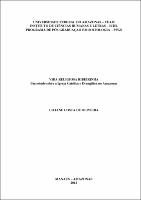| ???jsp.display-item.social.title??? |


|
Please use this identifier to cite or link to this item:
https://tede.ufam.edu.br/handle/tede/3359| ???metadata.dc.type???: | Dissertação |
| Title: | Vida religiosa ribeirinha: um estudo sobre a Igreja Católica e Evangélica no Amazonas |
| ???metadata.dc.creator???: | Oliveira, Liliane Costa de  |
| ???metadata.dc.contributor.advisor1???: | Pinto, Marilina Conceição Oliveira Bessa Serra |
| ???metadata.dc.description.resumo???: | A história da ocupação recente da Amazônia está diretamente relacionada com o encontro de culturas religiosas sustentadas socialmente por mundos materiais e espirituais distintos definidores do ethos vivido. Cabe destacar o Cristianismo como um dos principais movimentos religiosos introduzido na região, a princípio, pelo Catolicismo e mais tarde pelo Protestantismo. É possível perceber a influência que a igreja exerceu sobre a vida dos moradores, tornando-se depois da família uma das mais importantes instituições sociais. E na atualidade permanece exercendo domínio no processo de formação de novas comunidades, reproduzindo práticas messiânicas de evangelização e colonização. Entre as comunidades ribeirinhas de Jaiteua de Cima, Manacapuru/AM, são as Igrejas (evangélica e católica) que delimitam o espaço sociopolítico, pois o processo de implantação destas Igrejas no local está diretamente relacionado com a história da formação social das comunidades Nossa Senhora do Perpétuo Socorro e Assembléia de Deus. São as igrejas locais que ocupam o espaço de centralidade. Por isso, esse estudo sobre a vida religiosa merece destaque pois trata-se de um fenômeno que modifica simbolicamente as relações políticas e sociais de percepção espaço-temporais entre as comunidades ribeirinhas. As características mais visíveis dessas mudanças são, por exemplo, as construções de igrejas, a criação de um espaço próprio para o Santo Padroeiro, a substituição do termo compadre pelo termo paz do Senhor , o nível de importância de uma família para outra e os tipos de lazer, como a prática do futebol. Portanto, a vida religiosa funciona como um dos mais importantes mecanismos de garantia do poder entre as famílias, na medida em que aglutina e domina a comunidade, constituindo-se em um poder simbólico. Pretendemos neste trabalho analisar o modo de ocupação religiosa destas comunidades sob a ótica das teorias sociológicas de Max Weber, Émile Durkheim, Peter Berger, Pierre Bourdieu, Heraldo Maués e Gedeon Alencar e mostrar a possibilidade de confrontar o modelo teórico construído pelos autores com a observação empírica da realidade apontada. |
| Abstract: | The history of recent occupation of the Amazon is directly related to religious cultures meet, socially sustained by the material and spiritual worlds separate, lived defining ethos. It is worth mentioning Christianity as a major religious movements in the region introduced the principle of Catholicism and later by Protestantism. It s possible to see the influence that the church had on the lives of residents, becoming the family after one of the most important social institutions and acting field today remains in the process of forming new communities, playing practical messianic evangelization and colonization. Between the coastal communities of Jaiteua de Cima, Manacapuru / AM, are the churches (evangelical and Catholic) that define the socio-political space, because the process of implementation of these churches on the site is directly related to the history of the formation of social communities Nossa Senhora do Perpetuo Socorro and Assembleia de Deus. Are the churches on the site that occupy the central space, so that study on religious life deserves to be a phenomenon that modifies symbolically the political, social, spatial and temporal perception among coastal communities. The characteristics of these changes are more visible, for example, the construction of churches and creating a space for the patron saint, the replacement of the companion to use the term "peace of the Lord", the importance level for a family to another, types of leisure activities such as soccer practice with more or less intensity. Therefore, the religious life works as one of the most important assurance mechanisms of power between families in that it brings together and dominate the community, thus becoming a symbolic power. We want this work to analyze the mode of occupation of these religious communities from the perspective of sociological theories of Max Weber, Emile Durkheim, Peter Berger, Pierre Bourdieu, Heraldo Maues and Gedeon Alencar. Show the possibility of comparing the theoretical model constructed by the authors with the observation pointed to empirical reality. |
| Keywords: | Amazônia Amazonas Igreja Catolicismo Protestantismo Ribeirinho Amazon Amazon Church Catholicism Protestantism Riverside |
| ???metadata.dc.subject.cnpq???: | CIÊNCIAS HUMANAS: SOCIOLOGIA |
| Language: | por |
| ???metadata.dc.publisher.country???: | BR |
| Publisher: | Universidade Federal do Amazonas |
| ???metadata.dc.publisher.initials???: | UFAM |
| ???metadata.dc.publisher.department???: | Instituto de Ciências Humanas e Letras |
| ???metadata.dc.publisher.program???: | Programa de Pós-Graduação em Sociologia |
| Citation: | OLIVEIRA, Liliane Costa de. Vida Religiosa ribeirinha: Um estudo sobre a Igreja Católica e Evangélica no Amazonas. 2012. 155 f. Dissertação (Mestrado em Sociologia) - Universidade Federal do Amazonas, Manaus, 2012. |
| ???metadata.dc.rights???: | Acesso Aberto |
| URI: | http://tede.ufam.edu.br/handle/tede/3359 |
| Issue Date: | 25-May-2012 |
| Appears in Collections: | Mestrado em Sociologia |
Files in This Item:
| File | Description | Size | Format | |
|---|---|---|---|---|
| liliane costa.pdf | 1.99 MB | Adobe PDF |  Download/Open Preview |
Items in DSpace are protected by copyright, with all rights reserved, unless otherwise indicated.




